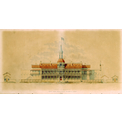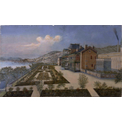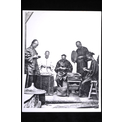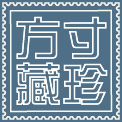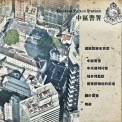After Hong Kong opened its ports to foreign trade in 1841, the city used silver sycees and Chinese cash coins as its main currency. Large quantities of foreign trade dollars also entered Hong Kong, and the Mexican eight-reales coin (commonly known as the “eagle dollar”) was listed as the standardised currency for trade. Hong Kong only got its own paper money in 1846 when the city’s first bank, the Oriental Bank, began issuing Hong Kong dollar banknotes. At that time, the “Hong Kong dollar” on the banknotes referred to their exchange value against the eagle dollar. As the demand for subsidiary coins and the eagle dollar continued to increase over the next decades, the Hong Kong government began ordering coins in denominations of ten cents and below from Britain in 1863. Then, in 1866, the Hong Kong Mint was founded to produce silver coins in denominations from five cents to one dollar locally, thus establishing the “dollar” as the city’s unit of currency. China, Japan and Korea later followed suit.
Foreign Currency in Circulation in Hong Kong
When Hong Kong first opened its ports to foreign trade, the city used the same types of currency as Guangzhou: the silver sycee was used for large commercial transactions while the silver dollar and Chinese cash coins were used for everyday purchases. Convenient to use and produced with precision, silver dollars did not need to be weighed and valued every time they were used, as silver sycees did, and they thus circulated widely in the city. The Mexican “eagle dollar”, which was abundantly available, was even listed as the standardised trade currency by the Hong Kong government as early as 1842. As foreign trade dollars were extremely popular in Hong Kong and China, the Qing government set up the Canton Mint in 1889 and began machine-striking “dragon dollars”. Despite the Hong Kong government’s ban on the use of foreign copper, silver and nickel coins in 1914, dragon dollars continued to circulate at a discount until the silver standard was abolished in 1935.
Hong Kong’s Earliest Coinage
Hong Kong’s first coins of its own were born in 1863. These one-mil, one-cent and ten-cent coins were all struck in Britain, and it was not until the Hong Kong Mint was founded in 1866 that Hong Kong got its own locally minted coins. Under the silver standard, the Hong Kong Mint focused on producing silver coins in a variety of denominations, while subsidiary coins in denominations of twenty cents and below were ordered by the government. The public could exchange subsidiary coins through the Treasury. Half-dollar (fifty cents) and one-dollar silver coins were ordered from banks and merchants direct. These coins, which carried the portrait of Queen Victoria, were not popular because they were not as convenient to use as the widely accepted “eagle dollar”, and the Hong Kong Mint closed down just two years after it was established because of a lack of orders. From 1872 onwards, the Hong Kong government once again ordered coins from Britain, although the highest denomination of these imports was half a dollar.
Hong Kong’s Earliest Paper Money
Hong Kong’s first bank, the Oriental Bank, opened for business in 1845 and began issuing banknotes the following year. Local banks in those days were all operated by foreign merchants; their main business consisted in exchanging currency (huidui) and granting loans (licai fangdai), and so their Chinese names all contained the words “hui” and “li”. Early banknotes were in effect receipts issued to the public for depositing silver, and these could be presented to the banks any time to be exchanged for silver to the value of the denomination. Issuing notes was thus tantamount to borrowing money from the public at no interest, and it was not surprising that many banks were established with the intention of printing banknotes. They were granted the right to issue banknotes by Royal Charter or ordinances enacted by the Hong Kong government. By 1866, Hong Kong was home to as many as six note-issuing banks, but it was not until 1894 that the first bank founded with Chinese (and foreign) funds began printing banknotes.


